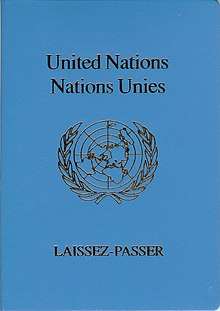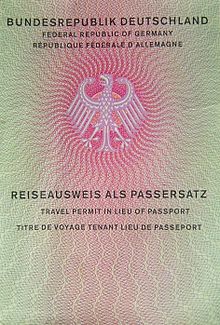Laissez-passer
A laissez-passer ( French "pass" ; lɛse paˈseː ) is a travel document that can take various forms and is issued by international organizations or national authorities.
Travel document of international organizations

The laissez-passer is issued by the European Commission and international organizations instead of service passports or diplomatic passports for selected employees. They can use a laissez-passer for business-related trips or the border crossing , whereby usually only member states of the international organization concerned are obliged to recognize the document.
Passport replacement
A laissez-passer is sometimes issued as a passport substitute for a single entry into a certain country, usually the home country. Such a document for entry into the home country is usually issued by the respective embassy of the destination country if no other travel document (passport) exists. Laissez-passer can also be issued by immigration authorities if there are corresponding agreements between the countries. The document is then used for the voluntary return or the forced return or deportation of migrants to their home countries if they do not have a valid travel document. Such a laissez-passer is not considered an international passport substitute.
Situation in the European Union
A multilateral transit agreement was signed on March 21, 2000 by the respective government representatives of Albania, Bosnia and Herzegovina, Germany, Italy, Croatia, Austria, Switzerland, Slovenia and Hungary and has been provisionally applied since April 20, 2000. It then finally came into force on May 17, 2001. Since October 2015, however, certain Balkan countries have been accepting the issue of replacement travel documents by German immigration authorities if they have checked the identity of the person concerned beforehand.
On October 13, 2016, the European interior ministers adopted a proposal from the European Commission to introduce a European travel document . This document aims to facilitate the return of third-country nationals who are staying illegally in the EU .
There is also an intra-European travel document. Such a travel document issued by an EU member state is known as an EU laissez passer . With the EU laissez passer, an asylum seeker can be transferred to the state that has to carry out the asylum procedure. The legal basis is Art. 19 Para. 3, Art. 20 Dublin II Regulation (now: Art. 29 Para. 1 Dublin III Regulation ).
Citizens from countries with which there are no corresponding agreements and who do not accept a European travel document cannot be repatriated unless the person required to leave the country independently lodges travel documents with the German authorities.
Individual evidence
- ↑ Section 24 of the Convention on the Privileges and Immunities of the United Nations.Retrieved May 30, 2018
- ↑ Regulation (EU) No. 1417/2013 of the Council of December 17, 2013 laying down the form of laissez-passers issued by the European Union (PDF)
- ↑ Bavarian State Ministry of the Interior: Aliens and Asylum Law: Termination of Residence of Kosovar Albanians from April 12, 2000 . April 12, 2000. Retrieved November 25, 2015.
- ↑ Federal Law Gazette : Announcement of the agreement on the approval of transit for Yugoslav citizens who are obliged to leave the country of May 17, 2001 . May 17, 2001. Retrieved November 25, 2015.
- ↑ Germany starts deportations with replacement papers . Reuters. November 24, 2015. Retrieved November 25, 2015.
- ↑ New European travel document for the return of third-country nationals adopted. European Commission, October 14, 2016, accessed February 25, 2018 .
- ↑ Dealing with rejected asylum seekers in Germany. Federal Office for Migration and Refugees, May 2016, accessed on February 2, 2018 .
